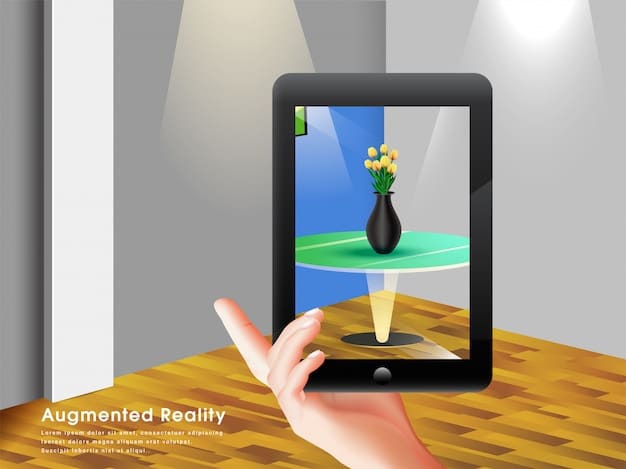The Role of Augmented Reality in Digital Marketing: Enhancing Customer Experience

Augmented reality (AR) is transforming digital marketing by creating immersive and interactive experiences that enhance customer engagement, brand loyalty, and ultimately, drive sales growth.
In today’s competitive digital landscape, businesses are constantly seeking innovative ways to stand out and connect with their target audience. One technology that has emerged as a game-changer is **augmented reality in digital marketing: enhancing the customer experience.** It provides a unique opportunity to blend the physical and digital worlds, offering consumers engaging and personalized experiences.
Understanding Augmented Reality and Its Impact
Augmented reality (AR) is no longer a futuristic concept confined to science fiction. It’s a tangible technology reshaping numerous industries, including digital marketing. This section will explore what AR is and its potential impact on how businesses interact with their customers.
What is Augmented Reality?
AR is an interactive experience where a real-world environment is enhanced by computer-generated perceptual information, usually visual, but also including auditory, haptic, somatosensory and olfactory. In simpler terms, AR overlays digital content onto the real world, creating an interactive and immersive experience. Unlike virtual reality (VR), which creates a completely virtual environment, AR enhances the existing reality.
The Impact on Digital Marketing
The impact of augmented reality on digital marketing is profound. It offers businesses a way to:
- Enhance Customer Engagement: AR experiences are inherently engaging and interactive, capturing the attention of customers in a way that traditional marketing methods often fail to do.
- Improve Brand Awareness: AR can create memorable and unique experiences that leave a lasting impression, boosting brand awareness and recall.
- Drive Sales: By allowing customers to virtually “try before they buy,” AR can increase purchase confidence and drive sales conversions.
Examples of AR Applications
From trying on virtual clothes to visualizing furniture in your home, AR applications are diverse and growing. Retail, entertainment, and real estate are just a few of the industries that are already leveraging AR to enhance their marketing efforts. Think of Sephora’s Virtual Artist, which allows users to try on makeup virtually, or IKEA’s Place app that enables users to see how furniture would look in their homes before purchasing. These experiences increase customer confidence and satisfaction.
In conclusion, understanding the fundamentals of augmented reality and its potential impact is crucial for businesses looking to innovate their digital marketing strategies. AR represents a paradigm shift in how brands can connect with their target audience, offering a more engaging, personalized, and ultimately, more effective approach.
Benefits of Augmented Reality in Marketing Campaigns
Augmented reality offers numerous benefits that can significantly enhance marketing campaigns. Beyond the novelty factor, AR provides tangible advantages that can translate into increased customer engagement, improved brand loyalty, and higher conversion rates. This section delves into the specific benefits that make AR a powerful tool for marketers.

Enhanced Customer Engagement
AR experiences are inherently interactive, captivating customers and encouraging them to spend more time engaging with a brand. This increased engagement can lead to stronger brand recall and a greater likelihood of future purchases. Customers are no longer passive recipients of marketing messages; they become active participants in the brand experience.
Improved Brand Awareness
AR offers a unique and memorable way to showcase a brand, helping it stand out from the competition. By creating innovative and engaging experiences, AR can significantly boost brand awareness and recognition. These experiences are often shareable, further amplifying the reach of the marketing campaign.
Increased Conversion Rates
One of the most significant benefits of AR is its ability to drive sales conversions. By allowing customers to virtually try products before they buy, AR can increase purchase confidence and reduce the risk of returns. This is particularly valuable for products that are difficult to visualize or try on in a traditional retail setting.
Personalized Experiences
AR can be tailored to deliver personalized experiences based on individual customer preferences and needs. This level of personalization can significantly enhance customer satisfaction and loyalty. By analyzing user data and behavior, AR applications can provide customized content and recommendations, creating experiences that resonate with each customer.
Data Collection and Insights
AR applications can collect valuable data about customer behavior and preferences, providing marketers with insights that can be used to optimize future campaigns. This data can include information about how users interact with the AR experience, which features they use most often, and what products they are most interested in. This allows for continuous refinement of marketing strategies.
In summary, the benefits of augmented reality in marketing campaigns are vast and compelling. From enhancing customer engagement to driving sales conversions, AR offers a unique opportunity for businesses to connect with their target audience in a more meaningful and effective way. By leveraging the power of AR, marketers can create truly memorable and impactful campaigns.
Implementing AR in Your Digital Marketing Strategy
Successfully integrating augmented reality into your digital marketing strategy requires careful planning and execution. This section provides a step-by-step guide to help you effectively implement AR in your campaigns, from defining your goals to measuring your results.
Define Your Objectives
The first step in implementing AR is to clearly define your objectives. What do you hope to achieve with AR? Are you looking to increase brand awareness, drive sales conversions, or enhance customer engagement? Defining your objectives will help you choose the right AR application and develop a strategy that aligns with your overall marketing goals.
Choose the Right AR Application
There are numerous AR applications available, each with its own strengths and weaknesses. Some popular AR applications include:
- Product Visualization: Allows customers to virtually see how products would look in their homes or on their bodies, like furniture or clothing.
- Interactive Games: Creates engaging and entertaining experiences that promote brand awareness.
- Augmented Reality Advertising: Integrates AR elements into existing advertising campaigns, like print or digital ads.
Develop Engaging Content
The success of your AR campaign depends on the quality of the content you create. Your AR content should be engaging, informative, and relevant to your target audience. Focus on creating experiences that are not only visually appealing but also provide value to the user.
Promote Your AR Campaign
Once you’ve developed your AR content, it’s important to promote it effectively. Use your existing marketing channels, such as social media, email marketing, and your website, to raise awareness of your AR campaign. Consider using QR codes or other visual cues to encourage users to download and use your AR application.
Measure Your Results
Finally, it’s essential to measure the results of your AR campaign. Track metrics such as engagement rate, conversion rate, and brand awareness to assess the effectiveness of your AR strategy. Use these insights to optimize future campaigns and improve your overall marketing performance.
In conclusion, implementing augmented reality in your digital marketing strategy requires careful planning and execution. By defining your objectives, choosing the right AR application, developing engaging content, promoting your campaign effectively, and measuring your results, you can harness the power of AR to achieve your marketing goals.
Examples of Successful AR Marketing Campaigns
To illustrate the potential of augmented reality in digital marketing, let’s examine some successful AR campaigns that have achieved significant results. These examples showcase the diverse ways in which AR can be used to enhance customer engagement, brand awareness, and sales.

IKEA Place
IKEA’s Place app is a prime example of product visualization using AR. The app allows customers to virtually place IKEA furniture in their homes, providing a realistic preview of how the furniture would look in their space. This has significantly increased purchase confidence and reduced the risk of returns.
Sephora Virtual Artist
Sephora’s Virtual Artist app lets users virtually try on makeup products using AR technology. Customers can experiment with different shades and styles without ever having to physically apply the makeup, saving time and minimizing the risk of allergic reactions. This has enhanced customer engagement and driven sales for Sephora.
L’Oréal Makeup
The L’Oréal Makeup app enables users to virtually try on various L’Oréal makeup products using their smartphone camera. This ensures customers can visualize how different shades and styles will appear on their faces. Customers can accurately visualize how different shades and styles will appear on their faces before making a purchase decision, leading to greater satisfaction and fewer returns.
Pepsi MAX
Pepsi MAX created an AR experience at a bus stop, making it appear as if there was a giant tiger, alien invasion, or other fantastical event happening in the street. This campaign generated significant buzz on social media and increased brand awareness for Pepsi MAX.
Timberland
Timberland implemented an interactive AR experience in their stores, allowing customers to virtually “try on” different styles of boots without physically wearing them. The virtual experience generated interesting social media presence and resulted in significantly increased sales.
These examples demonstrate the wide range of possibilities for augmented reality in digital marketing. From product visualization to interactive games, AR offers businesses a creative and effective way to connect with their customers and drive results.
Future Trends in Augmented Reality Marketing
The future of augmented reality in marketing is bright, with new technologies and applications constantly emerging. This section explores some of the key trends that are expected to shape the AR landscape in the years to come.
Advancements in AR Technology
As AR technology continues to evolve, we can expect to see more sophisticated and immersive experiences. This includes improvements in:
- 3D Modeling: More realistic and detailed 3D models will enhance the realism of AR experiences.
- Computer Vision: Improved computer vision capabilities will enable more accurate and seamless integration of digital content into the real world.
- Haptic Feedback: Haptic technology will add a sense of touch to AR experiences, making them even more engaging and immersive.
Integration with AI and Machine Learning
The integration of artificial intelligence (AI) and machine learning (ML) will further enhance the capabilities of AR. AI and ML can be used to:
- Personalize AR Experiences: AI can analyze user data to deliver customized content and recommendations.
- Optimize AR Campaigns: ML algorithms can identify patterns and insights from user behavior to optimize AR campaigns in real-time.
Growth of Mobile AR
Mobile AR is expected to continue to grow in popularity, as smartphones and tablets become increasingly powerful and AR-capable. This will make AR more accessible to a wider audience. This growth means more people will be able to access and interact with AR experiences through their personal devices.
AR in Retail and E-commerce
AR is poised to revolutionize the retail and e-commerce industries. AR can be used to:
- Enhance the Shopping Experience: AR can provide customers with a more immersive and engaging shopping experience, both online and in-store.
- Drive Sales: By allowing customers to virtually try products before they buy, AR can increase purchase confidence and drive sales conversions.
AR and Social Media
Social media platforms are already embracing AR, with features like AR filters and lenses. This trend is expected to continue, with social media becoming an increasingly important channel for AR marketing. This offers enhanced ways for brands to connect with customers and launch viral movements.
In conclusion, the future of augmented reality in marketing is full of potential. With advancements in technology, integration with AI and ML, and the growth of mobile AR, businesses can expect even more powerful and effective ways to connect with their target audience. By embracing these trends and experimenting with new applications, marketers can stay ahead of the curve and unlock the full potential of AR.
Overcoming Challenges in AR Marketing
While augmented reality offers numerous benefits for digital marketing, it’s important to acknowledge and address the challenges that can arise when implementing AR campaigns. This section explores some common obstacles and provides strategies for overcoming them.
High Development Costs
One of the biggest challenges of AR marketing is the high cost of developing AR applications and content. Creating engaging and high-quality AR experiences can require significant investment in software, hardware, and skilled personnel. To overcome this challenge:
- Start Small: Begin with a smaller, more focused AR campaign to test the waters and learn what works.
- Partner with Experts: Collaborate with experienced AR developers and agencies to leverage their expertise and reduce development costs.
Technical Limitations
AR technology is constantly evolving, but it still has some technical limitations. Factors such as processing power, battery life, and network connectivity can impact the performance and user experience of AR applications. To minimize technical issues:
- Optimize AR Content: Keep AR content lightweight and optimized for mobile devices.
- Test Thoroughly: Conduct extensive testing of AR applications on a variety of devices and networks.
User Adoption and Awareness
Another challenge is getting users to adopt and engage with AR experiences. Many consumers are still unfamiliar with AR technology, and may not understand how it works or what it can offer. To increase user adoption:
- Educate Your Audience: Clearly explain the benefits of your AR application and how to use it.
- Make it Easy to Use: Ensure that your AR experience is intuitive and user-friendly.
Measuring ROI
Measuring the return on investment (ROI) of AR marketing campaigns can be challenging. Traditional metrics such as click-through rates and conversion rates may not fully capture the value of AR experiences. To effectively measure ROI:
- Define Clear Goals: Set specific and measurable goals for your AR campaign.
- Track Key Metrics: Monitor metrics such as engagement rate, time spent in the AR experience, and brand awareness.
Privacy Concerns
AR applications may collect user data, raising privacy concerns. It’s important to be transparent about how you collect and use user data, and to comply with all applicable privacy regulations. Build trust with users by being open and honest about data practices. This will show trustworthiness and help encourage AR engagement.
In conclusion, while AR marketing offers many opportunities, it’s essential to be aware of and address the challenges that can arise. By planning carefully, partnering with experts, and focusing on user experience, businesses can overcome these obstacles and unlock the full potential of AR.
| Key Point | Brief Description |
|---|---|
| 💡 AR Definition | AR overlays digital content onto the real world, creating interactive experiences. |
| 🚀 Benefits for Marketing | Enhances engagement, boosts brand awareness, and increases conversion rates. |
| 📱 Implementation Steps | Define objectives, choose the right app, create engaging content, and measure results. |
| 🛍️ Successful Campaigns | IKEA Place and Sephora’s Virtual Artist, showcasing practical application. |
FAQ
▼
Augmented reality overlays digital content onto the real world, while virtual reality creates fully immersive, computer-generated environments. AR enhances reality; VR replaces it.
▼
Practical applications include product visualization (e.g., placing furniture in your home virtually), virtual try-ons (e.g., makeup or clothing), and interactive advertising campaigns.
▼
Businesses can measure ROI by tracking metrics such as engagement rate, conversion rate, time spent in the AR experience, and brand awareness uplift after the AR campaign.
▼
Challenges include high development costs, technical limitations, user adoption, accurately quantifying ROI, and privacy concerns as the AR applications are collecting user data.
▼
Future trends include advancements in AR tech, better AI/ML integration, more robust mobile AR, integration with social media and a revolution in retail marketing.
Conclusion
Augmented reality is rapidly transforming the digital marketing landscape, offering businesses a powerful tool to engage customers in new and innovative ways. By understanding the benefits, implementing effective strategies, and overcoming the challenges, businesses can harness the full potential of AR to improve brand awareness and drive incredible sales and customer lifetime loyalty. The future of marketing is undoubtedly augmented.





